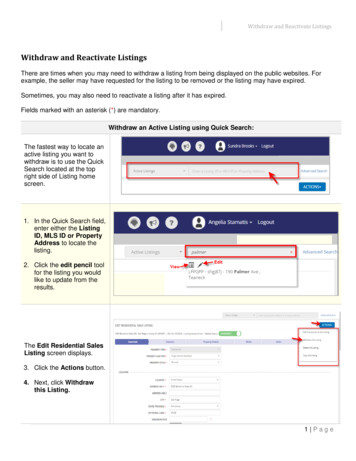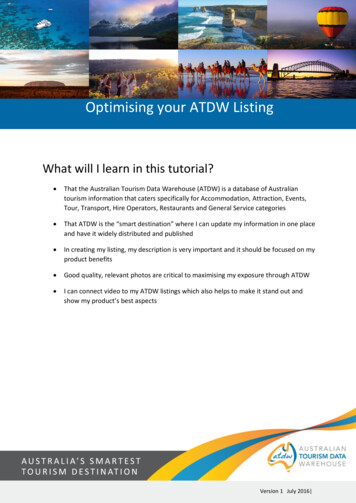
Transcription
Complete Listing of Chapter Opening Cases, Insight Cases,E-commerce in Action Cases, and Case StudiesCHAPTER 1 THE REVOLUTION IS JUST BEGINNINGOpening Case: Pinterest: A Picture Is Worth a Thousand WordsInsight on Technology: Will Apps Make the Web Irrelevant?Insight on Business: Start-Up Boot CampInsight on Society: Facebook and the Age of PrivacyCase Study: The Pirate Bay: Searching for a Safe HavenCHAPTER 2 E-COMMERCE BUSINESS MODELS AND CONCEPTSOpening Case: Twitter’s Business ModelInsight on Society: Foursquare: Check Your Privacy at the DoorInsight on Business: Crowdfunding Takes OffInsight on Technology: Battle of the Titans: Music in the CloudCase Study: Pandora and the Freemium Business ModelCHAPTER 3 E-COMMERCE INFRASTRUCTURE: THE INTERNET, WEB, AND MOBILEPLATFORMOpening Case: Google Glass: Augment My RealityInsight on Society: Government Surveillance and Regulation of the InternetInsight on Technology: Is HTML5 Ready for Prime Time?Insight on Business: The Apps EcosystemCase Study: Akamai Technologies: Attempting to Keep Supply Ahead of Demand
CHAPTER 4 BUILDING AN E-COMMERCE PRESENCE: WEB SITES, MOBILE SITES, AND APPSOpening Case: USA Today RedesignsInsight on Business: Curly Hair and AppillionairesInsight on Society: Designing for AccessibilityInsight on Technology: Building a Mobile PresenceCase Study: Orbitz Charts Its Mobile TrajectoryCHAPTER 5 E-COMMERCE SECURITY AND PAYMENT SYSTEMSOpening Case: Cyberwar: MAD 2.0Insight on Business: We Are LegionInsight on Technology: Think Your Smartphone Is Secure?Insight on Society: BitcoinCase Study: Online Payment Marketplace: Goat RodeoCHAPTER 6 E-COMMERCE MARKETING AND ADVERTISING CONCEPTSOpening Case: Video Ads: Shoot, Click, BuyInsight on Business: Are the Very Rich Different From You and Me?Insight on Technology: The Long Tail: Big Hits and Big MissesInsight on Society: Every Move You Take, Every Click You Make, We’ll Be Tracking YouCase Study: Instant Ads: Real-Time Marketing on Exchangescontinued on back inside cover
E -commercebusiness. technology. society.T e n T He d i t i o nKenneth C. LaudonCarol Guercio TraverNew York UniversityAzimuth Interactive, Inc.Boston Columbus Indianapolis New York San Francisco Upper Saddle RiverAmsterdam Cape Town Dubai London Madrid Milan Munich Paris Montreal TorontoDelhi Mexico City São Paulo Sydney Hong Kong Seoul Singapore Taipei Tokyo
Editor In Chief: Stephanie WallExecutive Editor: Bob HoranProgram Manager Team Lead: Ashley SantoraProgram Manager: Denise VaughnEditorial Assistant: Kaylee RotellaExecutive Marketing Manager: Anne K. FahlgrenProject Manager Team Lead: Judy LealeProject Manager: Karalyn HollandOperations Specialist: Michelle KleinCreative Director: Blair BrownSr. Art Director: Janet SlowikCover Designer: DePinho DesignCover Image: Shutterstock VLADGRINMedia Project Manager: Lisa RinaldiFull Service Project Management: AzimuthInteractive, Inc.Composition: Azimuth Interactive, Inc.Printer/Binder: Edwards Brothers MalloyCover Printer: Lehigh-Phoenix Color/HagarstownText Font: ITC Veljovic Std. Book, 9.5ptCredits and acknowledgements borrowed from other sources and reproduced, with permission, in thistextbook appear on page C-1.Microsoft and/or its respective suppliers make no representations about the suitability of the information contained in the documents andrelated graphics published as part of the services for any purpose. All such documents and related graphics are provided “as is” without warranty of any kind. Microsoft and/or its respective suppliers hereby disclaim all warranties and conditions with regard to this information,including all warranties and conditions of merchantability, whether express, implied or statutory, fitness for a particular purpose, title andnon-infringement. In no event shall Microsoft and/or its respective suppliers be liable for any special, indirect or consequential damages orany damages whatsoever resulting from loss of use, data or profits, whether in an action of contract, negligence or other tortious action, arising out of or in connection with the use or performance of information available from the services. The documents and related graphicscontained herein could include technical inaccuracies or typographical errors. Changes are periodically added to the information herein.Microsoft and/or its respective suppliers may make improvements and/or changes in the product(s) and/or the program(s) described hereinat any time. Partial screen shots may be viewed in full within the software version specified.Microsoft and Windows , and Microsoft Office are registered trademarks of the Microsoft Corporation in the U.S.A. and other countries.This book is not sponsored or endorsed by or affiliated with the Microsoft Corporation.Copyright 2014, 2013, 2012 by Kenneth C. Laudon and Carol Guercio Traver.Published by Pearson Education, Inc., One Lake Street, Upper Saddle River, New Jersey 07458. All rightsreserved. Manufactured in the United States of America. This publication is protected by copyright, andpermission should be obtained from the publisher prior to any prohibited reproduction, storage in aretrieval system, or transmission in any form or by any means, electronic, mechanical, photocopying,recording, or likewise. To obtain permission(s) to use material from this work, please submit a writtenrequest to Pearson Education, Inc., Permissions Department, One Lake Street, Upper Saddle River, NewJersey 07458, or you may fax your request to 201-236-3290.Many of the designations by manufacturers and sellers to distinguish their products are claimed astrademarks. Where those designations appear in this book, and the publisher was aware of a trademarkclaim, the designations have been printed in initial caps or all caps.Library of Congress Cataloging-in-Publication Information Is Available10 9 8 7 6 5 4 3 2 1ISBN 10: 0-13-302444-XISBN 13: 978-0-13-302444-9
P RE FA C EE-commerce. Business. Technology. Society. 10E provides you with an in-depth introduction to the field of e-commerce. We focus on concepts that will help you understandand take advantage of the evolving world of opportunity offered by e-commerce,which is dramatically altering the way business is conducted and driving major shiftsin the global economy.Just as important, we have tried to create a book that is thought-provoking andcurrent. We use the most recent data available, and focus on companies that you arelikely to encounter on a daily basis in your everyday life, such as Facebook, Google,Twitter, Amazon, YouTube, Pinterest, eBay, and many more that you will recognize,as well as some exciting startups that may be new to you. We also have up-to-datecoverage of the key topics in e-commerce today, from privacy and piracy, to government surveillance, cyberwar, social, local, and mobile marketing, Internet sales taxes,intellectual property, and more. You will find here the most up-to-date and comprehensive overview of e-commerce today.The e-commerce concepts you learn in this book will make you valuable topotential employers. The e-commerce job market is expanding rapidly. Many employers expect new employees to understand the basics of e-commerce, social and mobilemarketing, and how to develop an e-commerce presence. Every industry today istouched in at least some way by e-commerce. The information and knowledge youfind in this book will be valuable throughout your career, and after reading this book,we expect that you will be able to participate in, and even lead, management discussions of e-commerce for your firm.what’s new in the TENTH editionNew Chapter on Social, Mobile, and Local MarketingGiven the growing importance of social, mobile, and local marketing in e-commerce,we have written an entirely new chapter devoted to providing an in-depth examination of these topics. In this new chapter, you will learn how companies are usingFacebook, Twitter, and Pinterest for social marketing, how to begin a social marketingcampaign and how to measure results for each of these platforms. We provide similarexamination of mobile and local and location-based marketing as well.New InfographicsA variety of infographics throughout the book provide a more visual and intuitiveaccess to concepts and information. Infographics make it easier to see and rememberpatterns and relationships than traditional charts and graphs. iii
ivPrefaceCurrencyThe 10th edition features all new or updated opening, closing, and “Insight on” cases.The text, as well as all of the data, figures, and tables in the book, have been updatedthrough October 2013 with the latest marketing and business intelligence availablefrom eMarketer, Pew Internet & American Life Project, Forrester Research, comScore, Gartner Research, and other industry sources.What’s New in E-commerce 2014E-commerce today is greatly different from e-commerce only five years ago. TheiPhone was introduced in 2007. The iPad tablet was first introduced in 2010 and hasalready gone through several generations! The smartphone and tablet devices havechanged e-commerce into a social, local, and mobile experience. The 10th editionspotlights the following themes and content:Headlines Social, Mobile, Local: We have included an entirely new chapter describing social,mobile, and local marketing. Content about social networks, the mobile platformand local e-commerce appears throughout the book.»» Social networks such as Facebook, Twitter, Pinterest, and LinkedIn continuetheir rapid growth, laying the groundwork for a social network marketing platform»» The mobile platform composed of smartphones and tablet computers takes offand becomes a major factor in search, marketing, payment, retailing and services, and online content. Mobile device use poses new security and privacyissues as well.»» Location-based services lead to explosive growth in local advertising and marketing. Online privacy continues to deteriorate, driven by a culture of self-revelation andpowerful technologies for collecting personal information online without theknowledge or consent of users. Internet security risks increase; cyberwarfare becomes a new way of conductingwarfare among nation-states and a national security issue.Business E-commerce revenues surge after the recession. Internet advertising growth resumes, at a faster rate than traditional advertising. Social marketing grows faster than traditional online marketing like search anddisplay advertising. E-books take off and expand the market for text, supported by the iPad, Kindle,Nook, and iPhone. Streaming of popular TV shows and movies (Netflix, Amazon, and Hulu.com)becomes a reality, as Internet distributors and Hollywood and TV producers strikedeals for Web distribution that also protects intellectual property.
Preface “Free” and “freemium” business models compete to support digital content. New mobile payment platforms emerge to challenge PayPal. B2B e-commerce exceeds pre-recession levels as firms become more comfortablewith digital supply chains.Technology Smartphones, tablets, and e-book readers, along with associated software applications, and coupled with 4G cellular network expansion, fuel rapid growth of themobile platform. Investment in cloud computing increases, providing the computing infrastructurefor a massive increase in online digital information and e-commerce. Cloud-based streaming services for music and video challenge sales of downloadsand physical product. Software apps fuel growth in app sales, marketing, and advertising; transformingsoftware production and distribution. Touch interface operating systems dominate mobile devices. Windows 8 introduced with a touch screen interface, mimicking Apple’s iOS and Google Androidsmartphones. The cost of developing sophisticated Web sites continues to drop due to decliningsoftware and hardware prices and open source software tools. Internet and cellular network capacity is challenged by the rapid expansion indigital traffic generated by mobile devices; the use of bandwidth caps tier-pricingexpands. Internet telecommunications carriers support differential pricing to maintain astable Internet; opposed by Net neutrality groups pushing non-discriminatorypricing.Society The mobile, “always on” culture in business and family life continues to grow. Congress considers legislation to regulate the use of personal information forbehavioral tracking and targeting consumers online. States heat up the pursuit of taxes on Internet sales by Amazon and others. Intellectual property issues remain a source of conflict with significant movementtoward resolution in some areas, such as Google’s deals with Hollywood and thepublishing industry, and Apple’s and Amazon’s deals with e-book and magazinepublishers. P2P piracy traffic declines as paid streaming music and video gains ground,although digital piracy of online content remains a significant threat to Hollywoodand the music industry. Governments around the world increase surveillance of Internet users and Websites in response to national security threats; Google continues to tussle with Chinaand other countries over censorship and security issues. v
viPreface Venture capital investing in e-commerce explodes for social, mobile, and local software applications. Crowdfunding becomes a new source of funding for e-commerce start-ups.WELCOME TO THE NEW E-COMMERCESince it began in 1995, electronic commerce has grown in the United States from astanding start to a 419 billion retail, travel, and media business and a 4.7 trillionbusiness-to-business juggernaut, bringing about enormous change in business firms,markets, and consumer behavior. Economies and business firms around the globe arebeing similarly affected. During this relatively short time, e-commerce has itself beentransformed from its origin as a mechanism for online retail sales into somethingmuch broader. Today, e-commerce has become the platform for media and new,unique services and capabilities that aren’t found in the physical world. There is nophysical world counterpart to Facebook, Twittter, Google search, or a host of otherrecent online innovations from Pinterest and iTunes to Tumblr. Welcome to the newe-commerce!Although e-commerce today has been impacted by the worldwide economicrecession, in the next five years, e-commerce in all of its forms is still projected tocontinue growing at high single-digit rates, becoming the fastest growing form of commerce. Just as automobiles, airplanes, and electronics defined the twentieth century,so will e-commerce of all kinds define business and society in the twenty-first century. The rapid movement toward an e-commerce economy and society is being ledby both established business firms such as Walmart, Ford, IBM, Macy’s, and GeneralElectric, and newer entrepreneurial firms such as Google, Amazon, Apple, Facebook,Yahoo, Twitter, YouTube, and Photobucket. Students of business and information technology need a thorough grounding in electronic commerce in order to be effectiveand successful managers in the next decade. This book is written for tomorrow’smanagers.While newer firms such as Facebook, Tumblr, YouTube, Twitter, Pinterest, Flickr,and Square have grown explosively in the last two years and grab our attention, thetraditional forms of retail e-commerce and services also remain vital and have provento be more resilient than traditional retail channels in facing the economic recession.The experience of these firms from 1995 to the present is also a focus of this book.The defining characteristic of these firms is that they are profitable, sustainable, efficient, and innovative, with powerful brand names. Many of these now-experiencedretail and service firms, such as eBay, Amazon, E*Trade, Priceline, and Expedia, aresurvivors of the first era of e-commerce, from 1995 to spring 2000. These survivingfirms have evolved their business models, integrated their online and offline operations, and changed their revenue models to become profitable. Students must understand how to build these kinds of e-commerce businesses in order to help the businessfirms they manage to succeed in the e-commerce era.It would be foolish to ignore the lessons learned in the early period of e-commerce.Like so many technology revolutions in the past—automobiles, electricity, telephones, television, and biotechnology—there was an explosion of entrepreneurialefforts, followed by consolidation. By 2005, the survivors of the early period were
Prefacemoving to establish profitable businesses while maintaining rapid growth in revenues. In 2013, e-commerce is entering a new period of explosive entrenpreneurialactivity focusing on social networks and the mobile digital platform created by smartphones and tablet computers. These technologies and social behaviors are bringingabout extraordinary changes to our personal lives, markets, industries, individualbusinesses, and society as a whole. In 2012–2013, the stock values of Apple, Google,and Amazon hit new highs, along with many start-ups. E-commerce is generatingthousands of new jobs for young managers in all fields from marketing to management, entrepreneurial studies, and information systems. Today, e-commerce hasmoved into the mainstream life of established businesses that have the market brandsand financial muscle required for the long-term deployment of e-commerce technologies and methods. If you are working in an established business, chances are thefirm’s e-commerce capabilities and Web presence are important factors for its success.If you want to start a new business, chances are very good that the knowledge youlearn in this book will be very helpful.BUSINESS. TECHNOLOGY. SOCIETY.We believe that in order for business and technology students to really understande-commerce, they must understand the relationships among e-commerce businessconcerns, Internet technology, and the social and legal context of e-commerce. Thesethree themes permeate all aspects of e-commerce, and therefore, in each chapter, wepresent material that explores the business, technological, and social aspects of thatchapter’s main topic.Given the continued growth and diffusion of e-commerce, all students—regardless of their major discipline—must also understand the basic economic and businessforces driving e-commerce. E-commerce has created new electronic markets whereprices are more transparent, markets are global, and trading is highly efficient,though not perfect. E-commerce has a direct impact on a firm’s relationship with suppliers, customers, competitors, and partners, as well as how firms market products,advertise, and use brands. Whether you are interested in marketing and sales, design,production, finance, information systems, or logistics, you will need to know howe-commerce technologies can be used to reduce supply chain costs, increase production efficiency, and tighten the relationship with customers. This text is written tohelp you understand the fundamental business issues in e-commerce.We spend a considerable amount of effort analyzing the business models andstrategies of “pure-play” online companies and established businesses now employing“bricks-and-clicks” business models. We explore why e-commerce firms fail and thestrategic, financial, marketing, and organizational challenges they face. We also discuss how e-commerce firms learned from the mistakes of early firms, and how established firms are using e-commerce to succeed. Above all, we attempt to bring a strongsense of business realism and sensitivity to the often exaggerated descriptions ofe-commerce. As founders of a dot.com company and participants in the e-commercerevolution, we have learned that the “e” in e-commerce does not stand for “easy.”The Web and e-commerce have caused a major revolution in marketing andadvertising in the United States. We spend two chapters discussing online marketing vii
CHAPTER 6 E-COMMERCE MARKETING AND ADVERTISING CONCEPTS Opening Case: Video Ads: Shoot, Click, Buy Insight on Business: Are the Very Rich Different From You and Me? Insight on Technology: The Long Tail: Big Hits and Big Misses Insight on Society: Every Move You Take, Every Click You Make, We'll Be Tracking You











